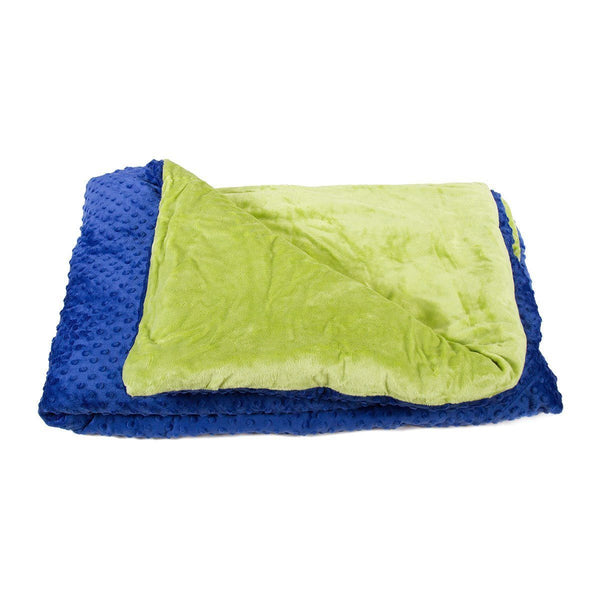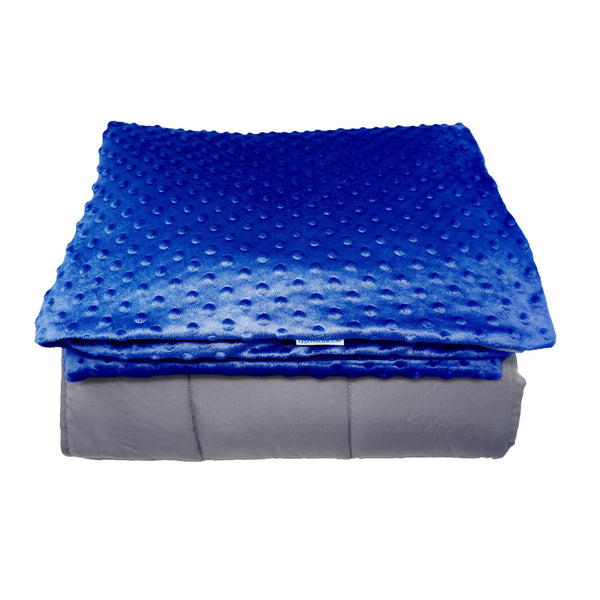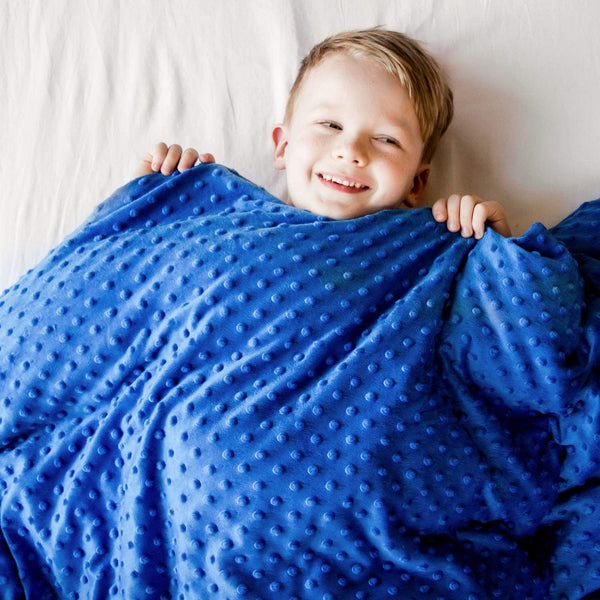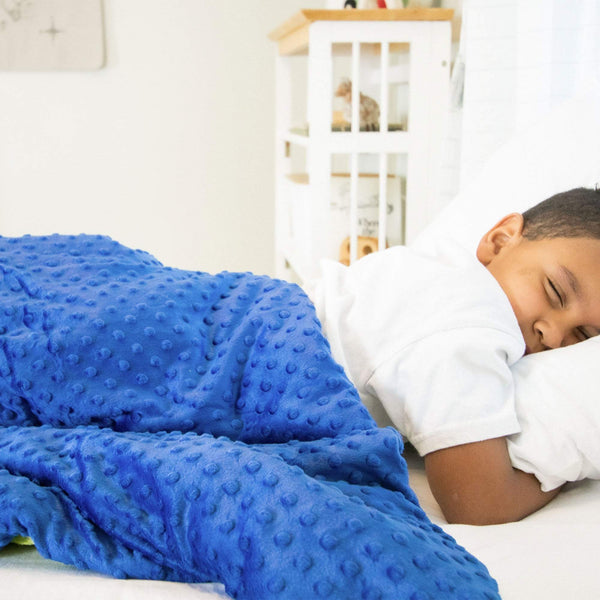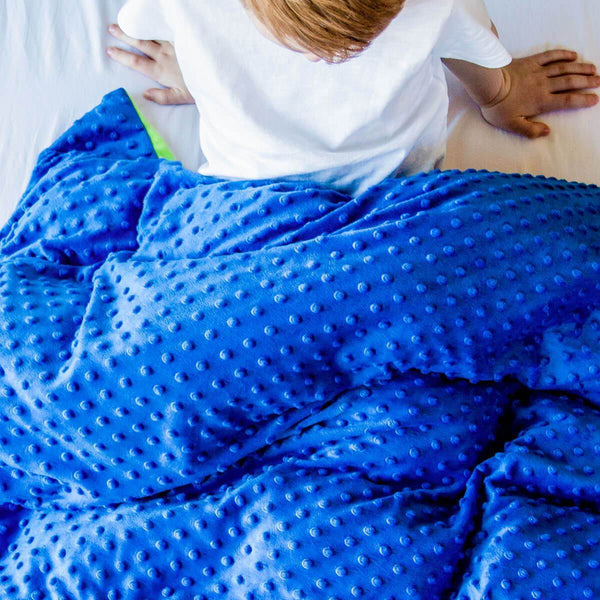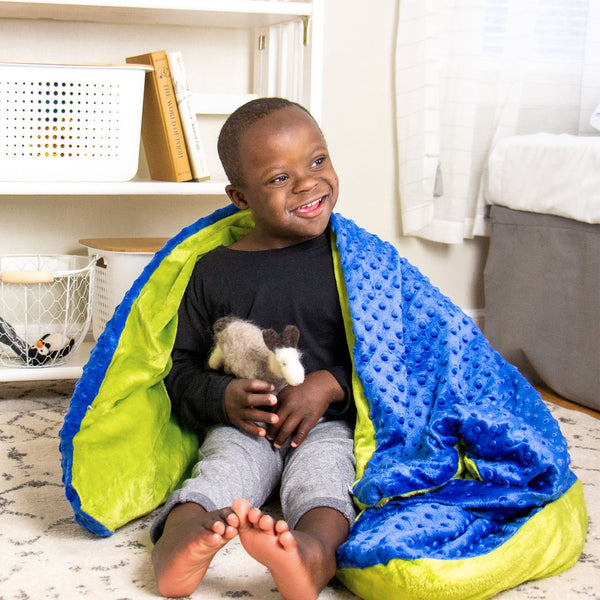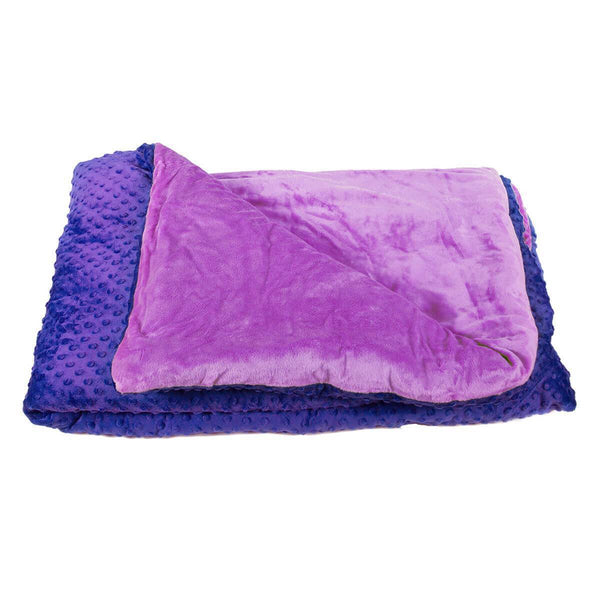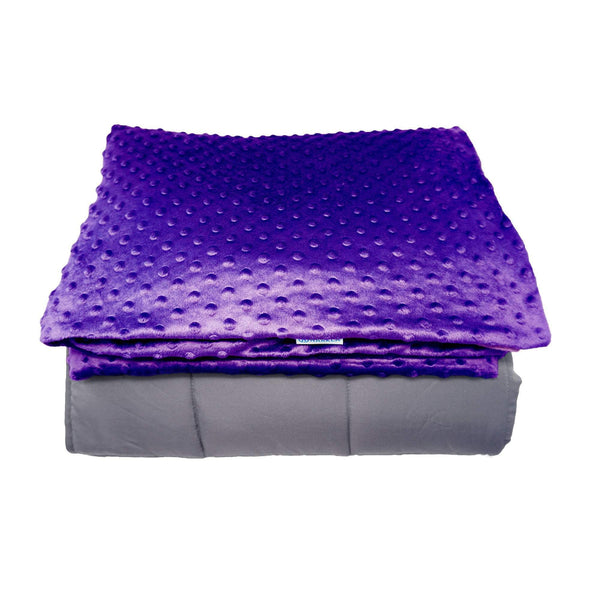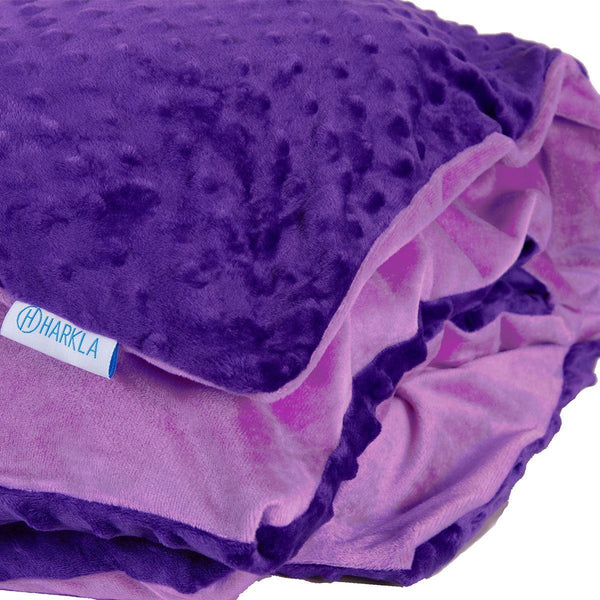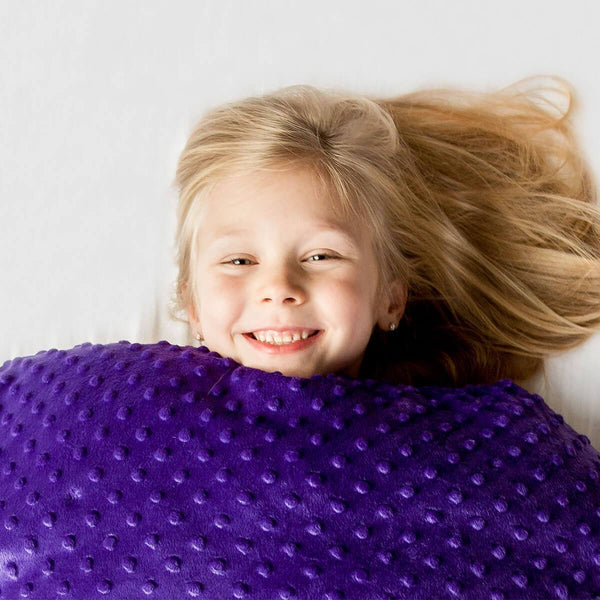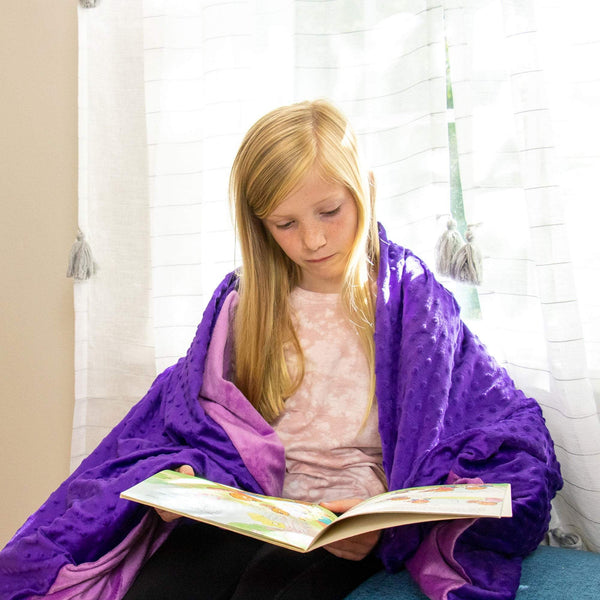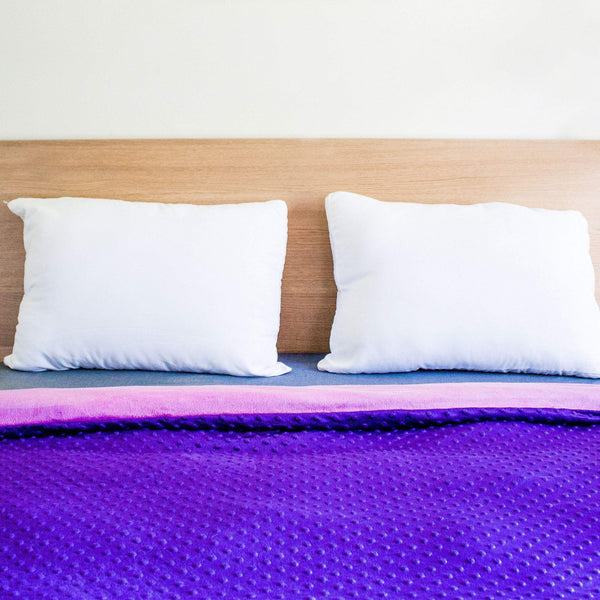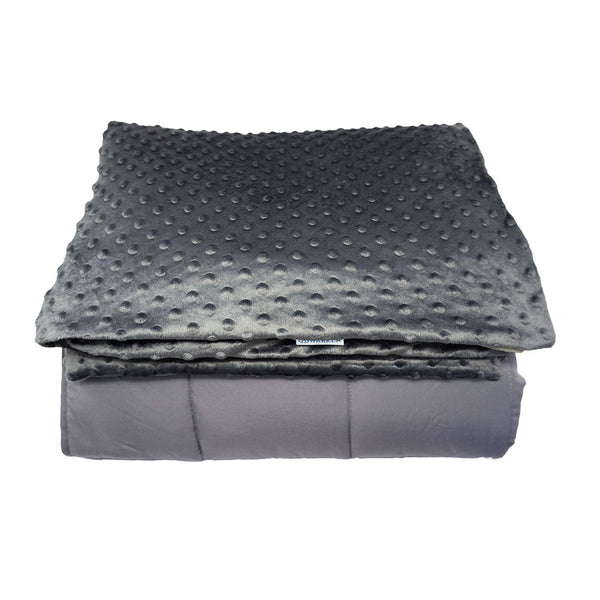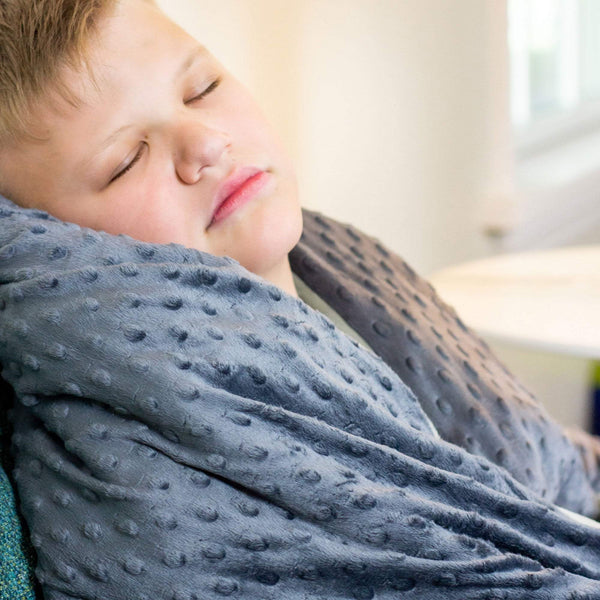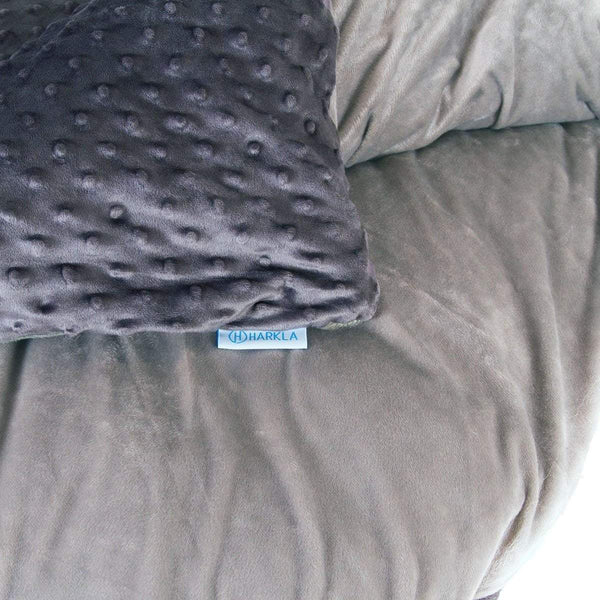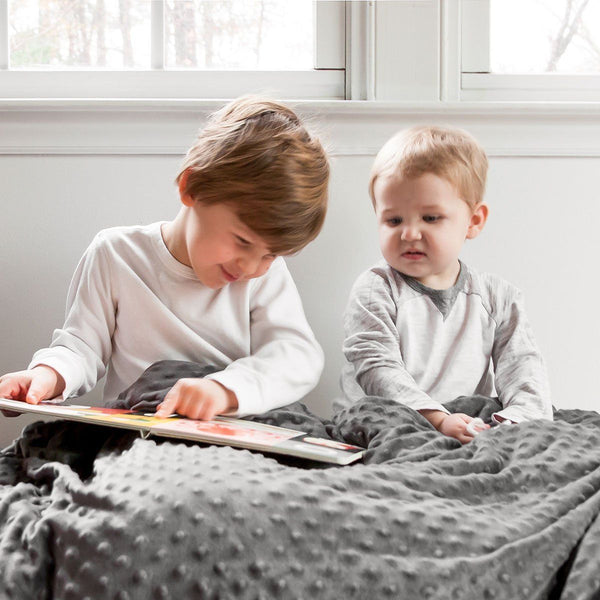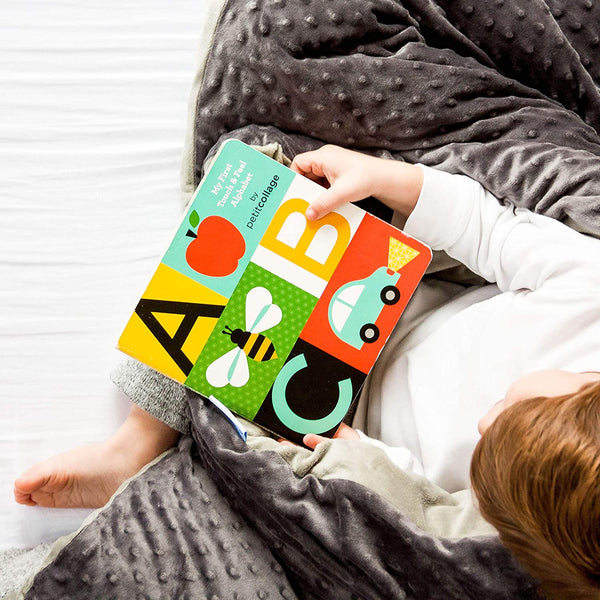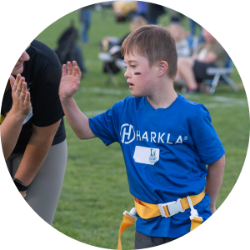Help Your Child Get A Good Night’s Sleep
“OUR 6 YEAR OLD HAS BEEN SLEEPING SO MUCH BETTER”
Have you struggled to help your child sleep? As parents we know that sleep is vital to a child’s development, but we don’t want to compromise with options that solve one issue just to create another. Harkla’s weighted blanket naturally helps your child calm down and get better sleep through deep touch pressure.
A Sense Of Calm For Your Child
NATURALLY SUPPORTS YOUR CHILD’S SENSORY NEEDS
Harkla's weighted blankets for kids help naturally calm the body through deep touch pressure. The weight helps your child by regulating their nervous system encouraging calm (It’s like receiving a hug!). Our kids weighted blankets are great for situations that are often stressful for sensory seekers like the classroom or car rides.
Designed For Everyday Life
DOTTED MINKY FABRIC. DUVET COVER.
The soft minky fabric design adds a sensory input to support your child's needs. The 2-piece duvet style removable cover makes it easy to remove the top layer to wash & dry at home.
The Harkla Weighted Blanket Is Designed To Be:
10% OF YOUR BODYWEIGHT + 1-2LBS
However, choosing the best weight is a matter of preference. Some are more comfortable with a blanket that is heavier or lighter than the recommended range. Our weighted blankets are designed to sit on top of the bed (unlike a traditional comforter that drapes over the mattress edges), so that the weight is less likely to slip off the side. The blanket should cover the proportions of the user's body, not the exact dimensions of a standard size mattress.
We think children with special needs should have every opportunity to live happy and healthy lives. That's why Harkla is dedicated to providing families with the best products and resources for raising a special needs child. Read more of our story here.
How Heavy Should My Weighted Blanket Be?
The rule of thumb for a weighted blanket is to be 10% of your body weight, plus a pound or two. So for a 60-pound child, our 7-pound blanket would work best.
What Are the Dimensions of the Blankets?
See Size Chart for blanket dimensions and to find your best snuggle size.

What is the Science Behind Weighted Blankets?
The science behind weighted blankets is called Deep Touch Pressure (DTP). DTP is simply distributed weight across the body. If you'd like to read more about the natural benefits of DTP, we wrote a guide to it here.
DTP releases serotonin in the body which turns into melatonin, as well as decreased nervous system activity. These combine to give a feeling of calm, relaxation and naturally improved sleep. If you'd like to dive into the studies about weighted blankets and the science behind them, we wrote an article on it here.
Who Do Weighted Blankets Work for?
Weighted blankets have historically been used for those with special needs, commonly referred to as autism blankets. However, they are beneficial to most people. Especially people who suffer from sleep issues.
If you'd like to dive into the benefits of weighted blankets for specific people, we have some articles covering that here:
Some families have used our weighted blankets for toddlers. We recommend the user be at least 2 years and up before using a toddler weighted blanket.
Where Do We Ship This Product?
From the Harkla Website, we only ship this product to the United States.
However, if you are looking for us in another country, we have options for purchasing!
Canada: Shop our store on Amazon Canada
Australia: Shop for us with our Australian Partner Starfish
If you're looking for another country, please check out our partner page to see if our products are available in your country through another retailer!
If you’d like to be informed of when we will be shipping to your country, please contact our customer service: support@harkla.co
What is the weighted blanket?
The weighted blanket from Harkla is made out of soft minky fabric with a 2-piece duvet style removable cover that is easy to remove and is machine washable. It is the perfect addition to bedtime because it provides just enough weight to help regulate the nervous system but not too much weight that it feels overwhelming. It’s soft, it’s easy to fold and roll up, and it’s a simple tool to add to your routine.
Who can benefit from the weighted blanket?
Well, really, ANYONE and EVERYONE!
Most people, even before knowing about weighted blankets, have tried using heavy blankets for sleeping or stacking a lot of blankets on top of each other.
While everyone can use better sleep, they were originally designed to be therapy blankets, specifical children with sensory processing challenges, including those with or without a diagnosis (i.e., Autism, ADHD, etc.), who struggle to fall and stay asleep at night.
Let’s break down the benefits of a weighted blanket!
Let’s look at a child who is struggling with bedtime - specifically falling asleep, which includes getting into bed and staying in bed. This child may crawl into bed at bedtime, but then they toss and turn, cannot get comfortable, refuse to close their eyes and get up out of bed several times.
They may also exhibit signs of anxiety or hyperactivity, despite the late hour. This child may benefit from using the weighted blanket during the bedtime routine - carrying it from the bedroom to the bathroom and back, using it while reading a bedtime story, etc. - as well as during the first 30-60 minutes of laying in bed. The calming weight may help this child get more comfortable and begin to drift off to sleep.
Now let’s look at a child who falls asleep easily enough but then wakes up several times throughout the night. This child is exhausted but cannot stay asleep for more than a couple of hours at a time (if that!). Then, once up, they struggle to fall asleep again. This happens several times every night, and come morning everyone is exhausted. This child may benefit from using the weighted blanket throughout the night, especially while initially falling asleep.
The weighted blanket can also be beneficial during other times of the day. If a child struggles to remain seated for a table-top, focused task, if a child struggles with riding in the car, if a child struggles with transitioning between tasks/activities - these are all opportunities to use the weighted blanket to provide calming proprioceptive input to improve anxiety, hyperactivity, focus, attention, and promote an overall sense of relaxation.
If you’re curious about more specific uses for weighted blankets, check out our articles:
What Sensory Inputs do Weighted Blankets Provide?
The weighted blanket specifically provides proprioceptive input - deep pressure and tactile input, which is also known as Deep Touch Pressure (DTP). This type of sensory input has been shown to provide a calming effect for a variety of individuals and situations.
Proprioceptive input
Proprioception is the awareness of the position and movement of the body. Sensory receptors are located on your skin, joints, and muscles. When we move, these sensory receptors send signals to our brain, telling it about the effort, force, and heaviness of the movement. Then our body is able to provide an appropriate response.
When we think about proprioceptive movement, we can also include heavy work - any type of movement that works the muscles and deep pressure - any type of input that provides pressure to our body, and vibration. Proprioceptive input is typically calming to the nervous system.
Individuals are usually not over-responsive to proprioception, meaning they don't have over-reactions to this type of sensory input. We do, however, see individuals who are under-responsive or sensory craving, meaning they want more heavy work, crashing, hugs, etc. These individuals typically respond well to the input that a weighted blanket provides.
The weighted blanket provides proprioceptive input as it lays on your body. You can lay it over just your feet or legs, up across your torso, or over your chest and arms - whatever feels good! You can also fold it to provide more weight, or roll it up and lay it next to your body. There are a lot of ways to fold and manipulate the weighted blanket to fit your needs.
Tips For Introducing The Weighted Blanket Your Child
Some children LOVE the weighted blanket immediately - these children love the weight that is provided.
However, some children are more hesitant when using the blanket and may be resistant for a variety of reasons. Some children do not like the new feeling initially - new and different can be hard! Additionally, some children struggle to process tactile input. While the blanket is made out of soft material, it is still new, and again, new can be challenging, especially for kiddos who are more rigid in their thinking! This is especially true for adding a new item to the bedtime routine.
The first thing we need to do when introducing the blanket is have empathy for the resistant child. Empathy allows us to look deeper, use our sensory goggles, and try to understand WHY the child is resisting.
If your child is resistant to using the weighted blanket, try these tips to engage them:
- Talk about what the blanket is for. Use positive verbiage. “This can help your body feel calm when you’re trying to fall asleep.”
- Start small. Allow your child to explore the blanket before using it. Take your time. Talk about how the material feels. Talk about how heavy it is.
- Try using it when your child is happy and calm during the day. “Hey, let’s try your blanket for 5 minutes while you’re playing!” This provides a positive association. Let them control when they want to stop using it for the moment.
- Use the blanket during play activities. Use it as a sled. Roll up like a burrito. Make the blanket seem fun.
- Once your child is comfortable with the blanket, start trialing it during the bedtime routine. “Let’s use your blanket while we read before bed.” Then talk about how it felt to use the blanket. “Did you feel calm or more silly when the blanket was on your lap?”
- Try adding a picture of the blanket to the child’s visual schedule or daily routine schedule so they can see a picture of when they’re expected to use it.
- Never force your child to use the weighted blanket. It is meant to be a positive tool, not a negative consequence.
- Don’t stress if your child seems to love the blanket one day but refuses it the next. Some days are better than others. Plus, as your child learns more about how their body feels, they may not need it every day/night.
It is recommended to use no more than 10% of the child’s body weight.
Always make sure that the child can move the blanket independently and it is not so heavy that they cannot move while under the blanket.
If your child says it’s not heavy enough, fold it to make it heavier.
Tips for Incorporating the Weighted Blanket into Your Child’s Routine:
Once your child is comfortable playing with and using the weighted blanket, you can begin to incorporate it into their day and evening as needed - to help with anxiety, focus and attention, sleep, and overstimulation.
Using the blanket at home:
- During the bedtime routine
- During the first 30-60 minutes in bed
- Intermittently throughout the night
- During a quiet break during the day
- While reading/watching TV
- During sit-down focus tasks at the table or laying on the floor
- While riding in the car
- During a break after school
Using the blanket at school:
- While seated during class time
- During a break, while reading or studying
- On the bus
Using the blanket in the community:
- Before leaving the house
- While riding in the car
- Anywhere that has a lot of auditory and visual stimuli (grocery store, park, etc.)
- After returning home
The goal is to provide just the right amount of calming input from the weighted blanket to help your child’s body feel cool, calm, and collected.
As your child experiences success using the weighted blanket, you can begin trialing shorter periods using the blanket. You can also trial less weight. Keep an eye on your child, talk with them to see how they feel, and adjust accordingly. If they don’t communicate with words, observe their body language and document everything!
Frequently Asked Question About Weighted Blankets
- How Young Is Too Young?
- The weighted blanket is not recommended for infants.
- A good rule of thumb is - if your child can independently lift and move the weighted blanket, it's safe for them to use it.
- How Heavey Should My Weighted Blanket Be?
- The weighted blanket is designed to be 10% of your body weight, plus 1-2 pounds extra if desired. Choosing the best weight is a matter of preference. Some are more comfortable with a blanket that is heavier or lighter than the recommended range.
- However, if the blanket is too heavy to lift and move independently, then it's too heavy for safety.
- How Do I Know When To Use the Weighted Blanket With My Child?
- This will vary person to person.
- If your child struggles with falling asleep, try using the blanket during the bedtime routine.
- If your child struggles with staying asleep through the night, try using the blanket throughout the night.
- If your child struggles with transitions or self-regulation, try using the blanket during daytime activities to provide calming, proprioceptive input.
- Why Doesn't The Weighted Blanket Fit The Entire Bed?
- The weighted blanket is designed to fit the body, not the bed.
- Weighted blankets are designed to sit on top of the bed (unlike a traditional comforter that drapes over the mattress edges), so that the weight is less likely to slip off the side. The blanket should cover the proportions of the user's body, not the exact dimensions of a standard size mattress.
- What Is The Science Behind Weighted Blankets?
- The science behind weighted blankets is called Deep Touch Pressure (DTP). DTP is simply distributed weight across the body. If you'd like to read more about the natural benefits of DTP, we wrote a guide to it here.
- DTP releases serotonin in the body which turns into melatonin, as well as decreased nervous system activity. These combine to give a feeling of calm, relaxation and naturally improved sleep.If you'd like to dive into the studies about weighted blankets and the science behind them, we wrote an article on it Here.
- Is It Safe To Use Every Night?
- As long as your child is not experiencing adverse reactions and as long as they can independently lift and move the blanket, it is safe to use.
- Why Does My Child Kick The Blanket Off Halfway Through The Night?
- There could be a variety of reasons for this. Perhaps your child moves a lot during sleep, or perhaps they got too hot under the blanket.
- If they are still sleeping through the night after kicking the blanket off, they are still getting the benefits of the deep pressure beforehand.
- Where do you ship this product?
- We ship to the US, Canada and the EU. For a list of other countries where we may have a partner please check out our website - https://harkla.co/pages/find-us-internationally
Final Thoughts
The weighted blanket can be a great addition to your child’s routine. There are so many ways to utilize the blanket in order to provide your child with a calm, organized sensory system in all environments.
Just remember, it’s not a magic fix or a quick fix to solving behavior and sensory challenges! It is a tool that can be used in coordination with other tools to help your child experience a happy life!
For more strategies and information, listen to All Things Sensory by Harkla podcast episode #68: Tips and Tricks for Using Weighted Products Efficiently.




